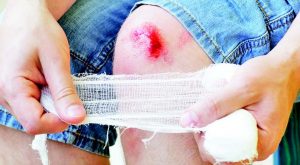Many people think that rabies is the big issue with animal bites—and to be honest, if there is a chance that the rabies virus is present, then it is.
However, you can get another medical condition from simply being wounded by an animal. This sickness is known as tetanus, and while its fatality rate is much lower than rabies, it can leave the victim coping with months in treatment and recovery.
This often-overlooked disease—which in the Philippines is more often related to stepping on or getting scratched by rusty nails or metal—also affects pet owners. Moreover, believe it or not, even our pets can be affected by it!
What is Tetanus?
You may have heard that you can get tetanus from rusty nails and manure from animals, and that’s actually true, as rusty nails and manure are materials that the bacteria can thrive in. It’s also found in dirt and soil.
The tetanus bacteria or spores themselves do not need oxygen to survive, which makes them dangerous when it comes to puncture wounds or open wounds. The real problem of tetanus bacteria is that they release a toxin that affects the nervous system, and this poisoning of our bodies creates the symptoms of the disease.
The name “tetanus” comes from the word “taut” or “to stretch.” This describes the general symptoms of the disease (see section on symptoms).
How You Get Tetanus
Since tetanus bacteria can survive on contaminated objects or surfaces, the common entry point in our bodies is through a wound. When it comes to handling our pets, this means that a deep scratch from the claws or a bite can be the point of entry—especially if yours is an outdoor-indoor pet.
The wound doesn’t even have to be too deep for the tetanus bacterium to latch on to our body’s tissues. Once it finds a favorable environment, the tetanus bacteria will start producing the poisons that will affect our bodies.
Thankfully, tetanus cannot be spread from person to person. You would need a sharp object laced with the bacteria for transmission to happen—by piercing the skin.
Here are some other ways that you can be infected with tetanus:
- Wounds not related to animals, but are suffered or inflicted in a dirty or contaminated place (i.e., you slip and open a wound in a garbage-filled area)
- Burns can also be entry points for the tetanus bacteria
- Injections and the tattooing process can lead to tetanus, if the needles are contaminated
- Body piercings can also cause tetanus, for the same reason as for tattooing
- Eye injuries can lead to tetanus, especially with contaminated materials hitting the eye
Something to Remember
While it’s not true that rust itself can cause tetanus, a dirty environment (where a rusty nail would be) can encourage the tetanus bacteria to grow. It’s no surprise, then, that pets such as cats and dogs may have some of the tetanus bacteria on or in them, particularly if they are very active outdoors, or if they are still being potty-trained.
What are the Symptoms of Tetanus?
Tetanus is known primarily for how it affects the muscles, either through muscle spasms, or through stiffness. This is because as the bacteria spreads through the dead tissues in the wound, they release poisons that affect the nerves that control muscles, leading to spasms and stiffness.
The most famous characteristic of tetanus is one that involves the jaw—hence the term “lockjaw,” where a person’s jaw “locks” into place, immovable. This is usually the first sign of the disease, and then the muscle spasms spread throughout the body.
Tetanus takes around five to twenty days to develop the first symptoms, though it usually starts ten days after exposure. Do be aware, though, that in some cases it can take months for the symptoms to show.
Here are the main symptoms:
- Lockjaw (Stiff Jaw Muscles) – this can make swallowing and even breathing a problem.
- Muscle Spasms – these spasms can be painful, and some have been known to break bones.
- Fever – tetanus-induced fevers are usually around 38 Celsius, a relatively high temperature.
- Sweating
- Fast Heart Rate
Aftermath:
Do note that while the muscle spasms and most of the other symptoms can be controlled, tetanus can lead to extended stays in the hospital or long-term bed rest, as your body has to repair the damage to your nerves. Depending on how severe the disease hit a person, it may take months to recover.
Go to a doctor now!
The earlier you go to a doctor to have your pet-related wound assessed, the easier it will be for you, as a booster shot will be much better than the combined medical costs of a full-blown tetanus attack.

How Tetanus is Treated?
- Vaccination (For Children)
The tetanus vaccine is usually given as part of a multi-vaccine injection series when they are babies. Another booster dose is given when children are around four years old, and another one is given at the age of 14 years. This set of injections should make most people immune for most, if not all their lives. However, if the bite or scratch wounds are deep, then you may have to be vaccinated again.
- Vaccination (For Adults)
If you are already an adult, and you aren’t sure that you’ve completed your vaccination shots, you should consult your family doctor for how to complete your vaccination. This is doubly important if you have pets, particularly those that can claw or bite.
- Vaccination (For Pets)
If you are handling pets of any kind, it’s always a good idea for you and your loved ones to be up to date on their tetanus vaccine shots.
This appeared in Animal Scene magazine’s January 2018 issue.






